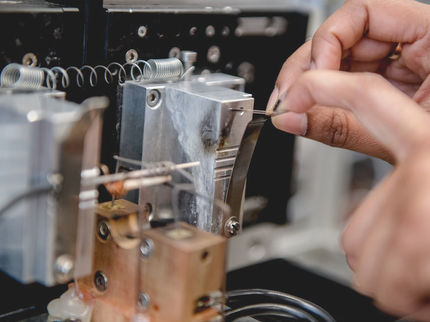New nanomethod paves the way for new measuring technology and hypersensitive sensors
Researchers at Chalmers University of Technology in Sweden have developed a new measurement technology that makes use of optical resonances in nanoparticles. The method, which opens new possibilities in the field of catalytics, will be published in the journal Science for November and is already available in the Web edition Science Express.
Optical resonances in nanoparticles, so-called plasmon resonances, have been the object of intensive research and development for about a decade now for detection of biological molecules and in optoelectronics.
The Chalmers scientists can now show that plasmon resonances in nanoparticles can be used to monitor reactions ON catalysts and for the design of sensors that are extremely sensitive.
The article is based on findings from doctoral work done by Elin Larsson and Christoph Langhammer. Co-authors are Igor Zoric and Bengt Kasemo, all in chemical physics at Chalmers.
The discoveries pave the way both for new measurement techniques in the nano field and the development of entirely new, hypersensitive sensors. With the new technology it will be possible to study catalysts in real time under realistic conditions, thus enhancing our knowledge of catalytic processes and helping develop new catalysts.
This helps bring down the use of both materials and energy in a number of processes and moreover reduces environmentally toxic emissions both from industry and vehicles.
Sensors are used daily in numerous areas, everything from medical diagnostics and control of industrial processes to combustion and catalytic cleaning of exhausts from vehicle engines. Today's sensors are often expensive and/or insufficient owing to short lifetimes, low selectivity and sensitivity, and lack of durability in demanding environments.
The new method is extremely robust and technologically simple, which will enable the development of inexpensive and robust sensors.
The research is continuing, targeting a number of diverse applications. Elin Larsson is further developing the method for the catalytic field at the Competence Center for Catalysis, KCK, at Chalmers.
Commercialization is being planned in the CleanSense Project, which was started within the framework of the Chalmers School of Entrepreneurship. The research has largely been pursued as part of the SSF-funded project Photoactive Nanostructures, and is now continuing in the Nanotechnology for Sustainable Energy Project, funded by the Chalmers Foundation and the Swedish Energy Agency.
Other news from the department science
Most read news
More news from our other portals
See the theme worlds for related content
Topic world Diagnostics
Diagnostics is at the heart of modern medicine and forms a crucial interface between research and patient care in the biotech and pharmaceutical industries. It not only enables early detection and monitoring of disease, but also plays a central role in individualized medicine by enabling targeted therapies based on an individual's genetic and molecular signature.

Topic world Diagnostics
Diagnostics is at the heart of modern medicine and forms a crucial interface between research and patient care in the biotech and pharmaceutical industries. It not only enables early detection and monitoring of disease, but also plays a central role in individualized medicine by enabling targeted therapies based on an individual's genetic and molecular signature.
























































